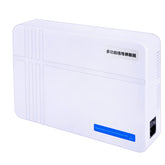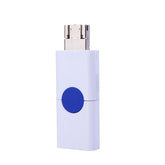how to detect wifi jammer
Detecting a wifi jammer can be a challenge, as jammers are designed to block the WiFi signal and make it difficult for devices to connect to the network. However, there are some steps you can take to detect a WiFi jammer:
Check for signal interference: One of the most common signs of a WiFi jammer is signal interference. If you notice that your WiFi signal is weak or intermittent, it may be a sign that a jammer is in use in the area. You can use a WiFi analyzer tool to scan for signal interference and identify any potential sources of interference.
Use a spectrum analyzer: A spectrum analyzer is a tool that can be used to detect radio frequency signals, including those emitted by a WiFi jammer. By scanning for radio frequency signals in the area, you can identify any potential sources of interference and determine if a jammer is in use.
Monitor network traffic: If a jammer is in use, it may be disrupting network traffic and causing devices to drop their connections. By monitoring network traffic, you can identify any patterns or anomalies that may indicate the use of a jammer.
Physical inspection: In some cases, a WiFi jammer may be visible and easy to detect. If you suspect that a jammer is in use, you can inspect the area for any devices or equipment that may be emitting radio signals.
It's important to note that the use of WiFi jammers may be restricted or even illegal in some situations, and it's important to use them responsibly and in accordance with the law. Additionally, it's important to consider the potential impact of a jammer on other wireless networks in the area, as it may cause interference and disrupt other devices.
By taking these steps to detect a WiFi jammer, you can improve network security and protect your WiFi network from potential security breaches. However, it's important to use these tools responsibly and in accordance with the law to ensure the privacy and security of your WiFi network.
Related jammer tag recommendations:
- 10
- 15
- 20
- 25
- 30
- 50
- Featured
- Best selling
- Alphabetically, A-Z
- Alphabetically, Z-A
- Price, low to high
- Price, high to low
- Date, old to new
- Date, new to old
Sort by:
- Featured
- Best selling
- Alphabetically, A-Z
- Alphabetically, Z-A
- Price, low to high
- Price, high to low
- Date, old to new
- Date, new to old
-
The mini usb gps jammer can block gps signals, which can help you avoid gps tracking. This USB blocker is very convenient because it can be charged by your android phone, computer, car charger, mobile phone charger with USB and android charging ports. feature:...
- $49.99
$80.00- $49.99
- Unit price
- / per
-
Our products all adopt the patch and high-density integrated circuit resistance, with advanced performance, stable work, ideal is to strengthen information security products, to protect your whereabouts secret and confidential information. The pocket GPS jammer is small jamming device that are extremely portable and...
- $99.69
$179.99- $99.69
- Unit price
- / per
-
The 5 bands portable GPS jammer aiming at car gps tracking,camera spying for those security Units and individuals to protect their privacy. It not only blocker the all GPS signals but also the mobile phone frequency. It can block a variety of signal frequencies,CDMA,...
- $288.99
$400.00- $288.99
- Unit price
- / per
-
This high-power 10-channel mobile phone signal shielding device, with the maximum transmitting power of 100W and the shielding radius of up to 30 meters, can effectively shield various 2G3G4G5GWIFI signals, and especially enhance the power push for 3G4G. The main body shell adopts the...
- $699.99
$1,000.00- $699.99
- Unit price
- / per
-
This three-antennas drone signal jammer has a good cooling system with built-in cooling fan, strong power,which make it works continuously and stably.You can adjust or shut down any frequency band without affecting the operation of other frequency bands.It can be used in meeting rooms,...
- $886.55
$1,200.00- $886.55
- Unit price
- / per
-
This High-power handheld (2G/3G/4G full-band) cell phone jammer with Wi-Fi/ GPS/LOJACK signal, easy to carry, flexible to use, and built-in large capacity battery, can be used in the Public Security, Police, The Bomb Squad, S.W.A.T, Military security forces ,Anti-terrorist units, Anti-drug units, Border control...
- $426.98
$600.00- $426.98
- Unit price
- / per





































